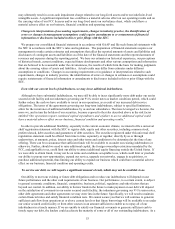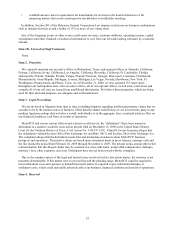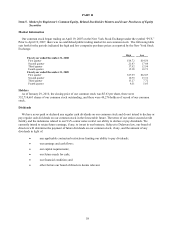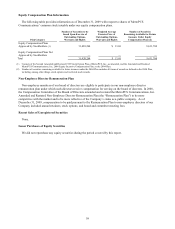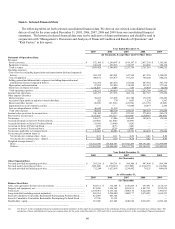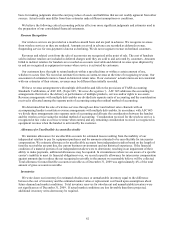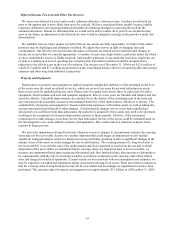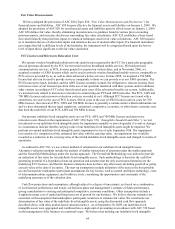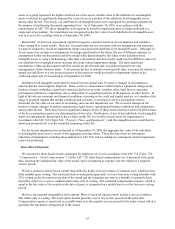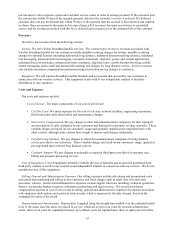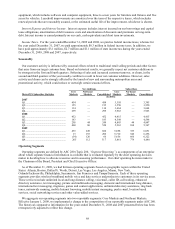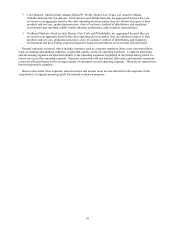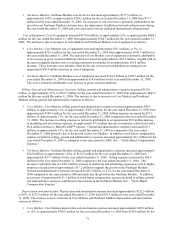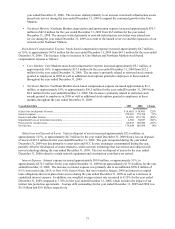Metro PCS 2009 Annual Report Download - page 75
Download and view the complete annual report
Please find page 75 of the 2009 Metro PCS annual report below. You can navigate through the pages in the report by either clicking on the pages listed below, or by using the keyword search tool below to find specific information within the annual report.63
Deferred Income Tax Asset and Other Tax Reserves
We assess our deferred tax asset and record a valuation allowance, when necessary, to reduce our deferred tax
asset to the amount that is more likely than not to be realized. We have considered future taxable income, taxable
temporary differences and ongoing prudent and feasible tax planning strategies in assessing the need for the
valuation allowance. Should we determine that we would not be able to realize all or part of our net deferred tax
asset in the future, an adjustment to the deferred tax asset would be charged to earnings in the period we made that
determination.
We establish reserves when, despite our belief that our tax returns are fully supportable, we believe that certain
positions may be challenged and ultimately modified. We adjust the reserves in light of changing facts and
circumstances. Our effective tax rate includes the impact of income tax related reserve positions and changes to
income tax reserves that we consider appropriate. A number of years may elapse before a particular matter for which
we have established a reserve is finally resolved. Unfavorable settlement of any particular issue may require the use
of cash or a reduction in our net operating loss carryforwards. Favorable resolution would be recognized as a
reduction to the effective rate in the year of resolution. Tax reserves as of December 31, 2009 were $12.6 million of
which $5.5 million and $7.1 million are presented on the consolidated balance sheet in accounts payable and accrued
expenses and other long-term liabilities, respectively.
Property and Equipment
Depreciation on property and equipment is applied using the straight-line method over the estimated useful lives
of the assets once the assets are placed in service, which are seven to ten years for network infrastructure assets,
three to ten years for capitalized interest, up to fifteen years for capital lease assets, three to eight years for office
equipment, which includes software and computer equipment, three to seven years for furniture and fixtures and five
years for vehicles. Leasehold improvements are amortized over the shorter of the remaining term of the lease and
any renewal periods reasonably assured or the estimated useful life of the improvement, whichever is shorter. The
estimated life of property and equipment is based on historical experience with similar assets, as well as taking into
account anticipated technological or other changes. If technological changes were to occur more rapidly than
anticipated or in a different form than anticipated, the useful lives assigned to these assets may need to be shortened,
resulting in the recognition of increased depreciation expense in future periods. Likewise, if the anticipated
technological or other changes occur more slowly than anticipated, the life of the assets could be extended based on
the life assigned to new assets added to property and equipment. This could result in a reduction of depreciation
expense in future periods.
We assess the impairment of long-lived assets whenever events or changes in circumstances indicate the carrying
value may not be recoverable. Factors we consider important that could trigger an impairment review include
significant underperformance relative to historical or projected future operating results or significant changes in the
manner of use of the assets or in the strategy for our overall business. The carrying amount of a long-lived asset is
not recoverable if it exceeds the sum of the undiscounted cash flows expected to result from the use and eventual
disposition of the asset. When we determine that the carrying value of a long-lived asset is not recoverable, we
measure any impairment based upon a projected discounted cash flow method using a discount rate we determine to
be commensurate with the risk involved and would be recorded as a reduction in the carrying value of the related
asset and charged to results of operations. If actual results are not consistent with our assumptions and estimates, we
may be exposed to an additional impairment charge associated with long-lived assets. There have been no indicators
that the carrying value of long-lived assets may not be recoverable and accordingly no impairment tests have been
performed. The carrying value of property and equipment was approximately $3.3 billion as of December 31, 2009.


